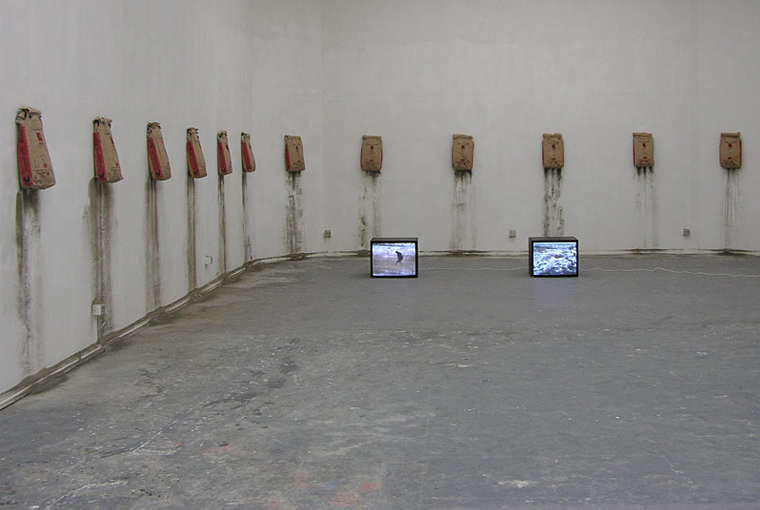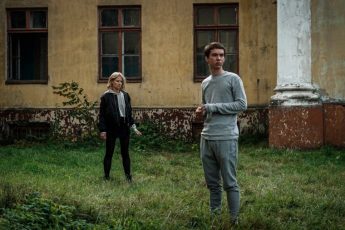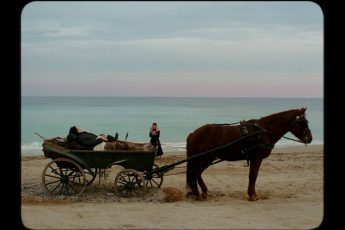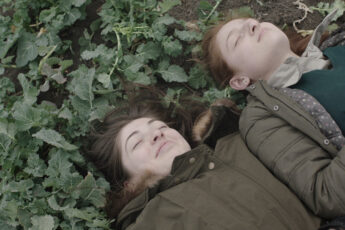Against Conceptualization
On Mona Vatamanu and Florin Tudor
Vol. 11 (November 2011) by Moritz Pfeifer
For a lot of people, video art is probably a rather enigmatic experience. As most video artists avoid casting, storytelling, suspense, the 90 to 120 minutes time frame and other defining elements of classic cinema, a certain fear comes from video art, namely that there is always some hidden message to decipher which the unversed spectator shamefully expects to miss. If one is not told what a video is about, one is likely to miss the point. The frightening aura video art perpetrates is thus that it is overly conceptual, so conceptual that once the message is discovered, the wish to actually watch the video for mere pleasure also disappears.
If one were to look at Vacaresti (2003), a video by Romanian artists Mona Vatamanu and Florin Tudor, one would see a more or less empty landscape covered with snow. If one looked a bit closer, one might recognize a man walking in the distance, but one would never guess what exactly he is doing. The walking man is Tudor himself, tracing the outlines of an 18th century monastery that was destroyed in the mid-eighties, probably to make way for Ceausescu’s only partially realized construction projects. The site of the monastery is now a total waste land, as Ceausescu failed to rebuild anything there before his death and the fall of Communism.
The artist’s gesture to recreate the invisible walls of the monastery with strings could be seen as an attempt to make the invisible visible, to let the forgotten traces of a destructive past reappear under signs of collective amnesia. Indeed, the construction of a shopping mall nearby does not necessarily sanctify Romania’s commitment for the preservation of historical monuments. The performative meaning of this video is thus explained, but mostly with words not with images. It is only by deciphering the concept – ie. having the knowledge about the monastery and the meaning of the performative gesture – that the video makes sense, as without it one is looking at a snow-covered field. But then again the point of the film, as the artists see it, is that one should not understand what is going on, since this feeling of lack reflects the absence of the monastery on the field as well as the impossibility of remembering it.
Rather an uninformed spectator myself I consulted some texts (published in a monograph by BAK, basis voor actuele kunst in the Netherlands) after having seen Vatamanu and Tudor’s works, in the need to find clarifications, contextualization and maybe even interpretations of their work that would go beyond restating the intentions of the artists. But it turns out that writing about video art can be as frightening as video art itself. Sadly, the author’s in this monograph have more to say on Foucault, Neoliberalism, and Jean-Luc Nancy than about Mona Vatamanu and Florin Tudor. Why? Because even the most complex philosophical thought is easier to understand than video art? Or is it only the prejudice against the complexity of video art that justifies half-witted complications of simple philosophy?
Concepts are boring, on screen or on paper. They only make sense under certain, very precise circumstances. Peeled away concepts, concepts without the vitality of a context, have nothing more to give than the naked formalizations of standardized arguments. Here is Cosmin Costinas on Vacaresti: “Thus the action in Vatamanu and Tudor’s Vacaresti is one of retracing a past that fell into oblivion, of a symbolic fight with amnesia…” A similar conclusion has been drawn from this analysis,
…but it cannot be reduced to that. It [the performance] does not assume a full scale (and hence equally amnesic) reconstruction, but through the mere act of re-tracing shows itself as an emphatic form of resistance. Its form borrows almost ironically the act of foundation in pre-modern architecture, in an Eliadesque twist of addressing an archetypical pattern. But Vacaresti is not an archetypical gesture as it declines to repeat ritualistically an unchangeable motif of the relationship of man to the world. It is however universal in its scale of approaching the politics of handling memory and reconciliation…1
In this passage the author is concerned with memory and reconstruction. The first sentence about resistance brings forth an interesting argument, namely that the author prefers Tudor’s symbolic performance to real reproductions of historical monuments, like the crazy idea of rebuilding the Stadtschloss in Berlin…For the author, as for Tudor, to really reconstruct something that has been demolished also forbids remembrance, as there is the danger of pretending that nothing happened to the reconstructed building in the first place. Reconstruction, in that sense, is just another form of amnesia. The author then analyzes Tudor’s performance in terms of archetypes, apparently because there is an archaic side to the demarcation of space. But the author quickly refuses to call the performance archetypical, borrowing the definition of archetypes from Mircea Eliade (a Romanian born Historian). For Mircea Eliade, archetypes are universal forms, ideas, etc. that societies throughout the world have repeatedly represented with non-universal words, images, etc. So what is at stake in this video is not the repetition of a universal achievement like the creation of a house, but a very precise historical moment, namely the impossibility of remembering the destroyed monument. In the last sentence, the term archetypical is then equated with universality, which now that one knows that for Mircea Eliade universality and archetypes are similar terms, makes sense. For the author however, there still remains an archetypical/universal side to Tudor’s performance because remembering history is something all societies share. The author then returns to the political meaning of memory briefly stated in the beginning of the paragraph, where he claimed that performance – because it is a short lived experience – resists the production of nostalgic kitsch. The power of dealing with history in a performative way, is thus that performance is able to communicate historical consciousness without becoming part of history itself. If for example a statue would commemorate the monastery, it would become part of history because it has a certain style, epoch, and other material data, that can be related to history. A performance disappears with its ending (unless it is recorded on film…). That’s why performance is more political than historical, as it really deals with the different political conflicts surrounding the historical event – destruction, denial, reconstruction – and not with the event itself. For the author, this political meaning of Tudor’s performance seems to be a universal need.
These thoughts are relevant. The only problem with the original argument is that it does not make sense as it is, without further explanation. In a way, this paragraph exemplifies a tendency in art criticism that is tied to a trend in video art, which is that of conceptualization. Like Vacaresti, the text on Vacaresti needs yet another text to make sense of its concepts. Like the video, the text on the video has to be explained by something outside of it. Without the explanation, the concepts give a similar feeling of a person looking at a field covered with snow, which is at best puzzlement and at worse emptiness. The only difference between text and video is that a text is a comment on the video, so while the artwork might be in need of the text but still exists without it, the text somehow confuses itself with the artwork, needing its own explination.
Conceptualization is arrogant. Artworks and texts that depend on concepts are so much in love with themselves that they think others will guess or look up the concept they consider too precious to display. No artwork or text can be self-explanatory but concepts should be addressed upon the completion of an artwork not be the reason for its beginning. This is, in my opinion, what happens with most of the texts that conceptualize. Instead of actually thinking about an artwork and then considering what it might mean, the meaning/concept is already so present that the only thing to do is to crush the work into the concept. The problem is that in doing this both artwork and concept fall short. The concept neither explains/questions the artwork nor does the artwork explain/question the concept. Concept and artwork just coincidentally overlap never having the chance to meet.
Conceptual Art, where a concept is actually at the source of an artwork, does not conceptualize because here, the concept is always part of the game, it is never outside of the artwork or else the entire artwork is outside itself. This is also the difference between Vacaresti and the critic’s text on Vacaresti. Vacaresti could be called a conceptual artwork because the performance and its mnemonic meaning are more important than the video documenting it. But the concept the video documents cannot be communicated without the video. Looking at the video, one is forced to turn back to the concept, and in a sort of circular movement establish a link between concept and work. Playing this circular game is part of what conceptual art is all about. But the rules of this game definitely do not apply to standard criticism. Thus in the text on Vacaresti the concepts (Mircea Eliade, historical reconstruction, etc.) are also more important than the text, but the job of linking the concept with the work (here, with the text) should be made by the author himself, not by his readers. Formalist minimalism in texts is a dead end. Why even bother creating a form for a text that is so dependent on prefabricated concepts that every attempt to connect its content with these concepts has to fail?
This said, it might be fruitful to look at some concepts Vatamanu and Tudor use, even though they would surely deny being called conceptual artists. Nevertheless, there are some themes and methods the artists like to return to. One of these – remembering Romania’s destructive history – has already been mentioned. A major model for these reflections on memory is architecture. Vacaresti (2003), Palatul (2003-2004), Procesul (2004-2005), and Praful (2006) are videos that all deal with the destruction of past architectural space that had to cede to the ideological reconstruction plans of Communist Romania. Vacaresti, the filmed performance on the monastery site, is a good example for this.
Perhaps the most striking video in this series, however, is a two-part video installation called Palatul, where two tour guides in the House of Parliament are filmed doing their job. For the artists, the difference of discourse and attitude of the two guides very much reflects a broader polarization of how history is perceived within Romanian society. Here, as in Vacaresti, conflicting contemporary views on historically significant architecture are at stake.
The first guide in this installation is a young man dressed in jeans and sweater. He could be a student and wears a scarf over his shoulders, which gives him the allure of a priest. It soon becomes clear that he is proud of the monument. He seems to like his job and spends most of his words on the exclusivity of the material used to built the palace. He might appear chesty, bossing the tourists around, but there is something obviously ridiculous about him, the overemphasizing of his British accent, and also about his pride, which he seems to be semi-aware of, ironically warning the visitors that “if you touch, you pay.” It is also hard to think that his propagandist opinion: “In order to complete the project in five years time, Ceausescu had destroyed the old city of Bucharest, demolished houses, palaces, churches a hospital, around five square miles to build one project for him and the communist members and also he had relocated around four thousand people, a small prize to pay to build the House of the People” is meant without an ironic undertone. The other guide is a woman whose voice is mild and gives all the facts and information expected of her. She does seem rather disillusioned and doesn’t seem to enjoy her job that much. The artists described her as unhappy, and uncomfortable.
The contrast is quite clear. On the one hand, there is the sporting enthusiast whose mode of survival is not to be too critical. If one wants to be go on with life, there is no point to look back and get depressed about the misfortunes of the past or, considering the guide’s age, mourn over other people’s responsibilities. History is a farce for those who are not part of it. On the other hand, there is a powerless woman overwhelmed by the atrocities of history that she has to tell on end.
Here one could return to the discussion about resistance that has been mentioned above. It has been said that performance is a form of historical resistance, which it achieves in two ways 1) it is short-lived and 2) its main concern is to point at the various political interests that historicizing generates instead of participating in the construction of history itself. In short, performance is a kind of awareness-maker. Palatul is not a performance, but there is an obvious performative side to the male tour guide, which might have been the reason for the artists to film him in the first place. The interesting question to ask is thus whether the guide is actually on the same level as the artists. Like the artists, the tour guide is also less concerned with a specific version of a historical narrative that he wants to communicate, but represents history’s absurdities in a performative way. One could then say that the guide’s form of resistance lies precicely in the over-identification of the palace, as it is the key for his spectators to grasp and become aware of the political antagonisms surrounding it. This might give the guard too much credit, but even if he is less conscious of his performative meaning, does the effect not stay the same?
While the guide’s boasting performance protects him from the melancholy of his colleague, Vatamanu and Tudor’s work renounces exaggeration or irony. Unlike for example Ujica’s recent documentary on Ceausescu (The Autobiography of Nicolae Ceausescu), they don’t mock the past in comfortable retrospect. They are not detached awareness-makers only using already existing material – ideas, buildings, history – to reveal present-day controversies. On the contrary, their work might have more in common with the female guide telling sad tales about the past. Initially, truth was the motivation for Tudor and Vatamanu to film these guides, as one of them said that the things that got destroyed were not important. Thus again, the absence of mourning about something no longer there is at the heart of this video installation.
In response to the claim that Vatamanu and Tudor’s work resists historicizing made in the above citation, one might ask if politicizing performances displayed in videos such as Vacaresti or Palatul are not themselves part of some historical process that ties them to the events they supposedly only mediate. Can performance/mediation not also be seen as a kind of statue, with its proper aesthetic, style, and reason all of which have historical significance?
One reason, that of mourning, has already been mentioned as a recurring theme and can definitely be seen as a historical process crucial to any post-dictatorial experience. But unlike the female guide, for instance, Vatamanu and Tudor’s work is not singing lamentations about the destructions of the past. Again, they are more concerned with the truth, or with lies of those people who do not recognize these destructions and who pretend that there is no loss of the things that are gone. In other words, they mourn over mourning. To claim however, that this detaches them in any way from history or from any other sociopolitical bondage is unclear. It’s like saying that any reflection on some feeling having the same feeling as an effect, is somehow surpassing that feeling. Reflecting on the incapacity of other people to mourn is still tied to a profound feeling of mourning. It just adds another form of mourning to an already existing one, and is thus doubly aggravated, not overcome.




Leave a Comment